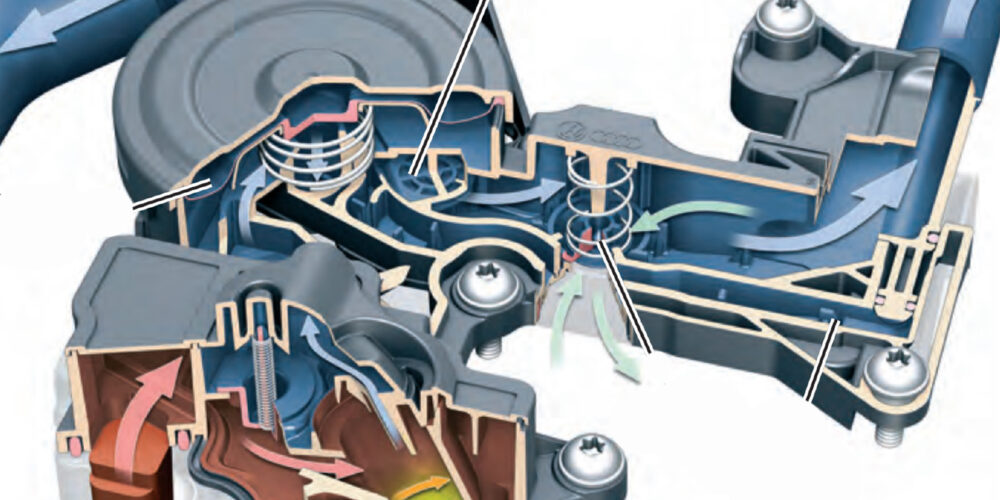Engine Management System: The Basics
The purpose of the engine management system (EMS) is to apply the correct amount of gasoline to the air entering the engine, while igniting the compressed air/fuel mixture at the right time within the cylinder. When an average Stoichiometric ratio of 14.7 lbs. of air to 1 lb. of gasoline is maintained, the EMS provides adequate oxygen for the reduction of harmful pollutants, as well as a rich enough mixture to prevent the catalyst from overheating.
The EMS uses one or more oxygen sensors to monitor combustion by measuring the oxygen content in the exhaust. And, in order for the catalytic converter to perform at its full potential, the EMS uses information from the oxygen sensors mounted before and after the catalytic converter.
Oxygen Sensors: The ‘How’ and ‘Why’
Oxygen sensors have to reach an approximate operating temperature between 600˚ and 650˚ F to produce valid data for closed-loop fuel control. In order to enter closed-loop sooner, oxygen sensors are equipped with a heater circuit, which provides power from a fused source and is ground-switched by the EMS processor.
Upstream oxygen sensors (typically located in the exhaust manifolds) are used to maintain control over the air/fuel mixture. Downstream oxygen sensors (located in the exhaust stream after the catalyst), are used by the EMS to monitor catalytic converter efficiency. In some engine management configurations, downstream oxygen sensor activity is used to adjust the air/fuel operation to maintain a favorable ratio to optimize catalyst efficiency.
Common Types of Oxygen Sensors
While all oxygen sensors serve the same purpose – to provide feedback to enable the EMS to maintain a suitable air/fuel ratio – several types of sensors can be found in current production vehicles.
Common oxygen sensor types include:
1) Zirconia dioxide
2) Planar
3) Titania
4) Wide-band air/fuel ratio.
1) Zirconia dioxide oxygen sensors generate a voltage proportionate to the oxygen content of the exhaust. When the oxygen in the exhaust is high (lean mixture), the voltage produced is low.
Conversely, rich mixtures (low oxygen content) are indicated by high voltage. The voltage range is 0 to 1 volt.
2) More stringent exhaust emission requirements in the mid-1990s led to the development of heated planar sensors, which deliver a reading that can be used for accurate fuel control within 12 seconds after an engine is started. First introduced in 1998, planar sensors now account for about 50 percent of oxygen sensors installed in new vehicles in the United States, and that number is growing rapidly.
3) The Titania oxygen sensor is a variable resistor-type sensor. As the oxygen content in the exhaust changes, the resistance of the oxygen sensor changes, too. Depending on the condition (rich or lean), the resistance causes the sensor reference voltage to rise or fall. A lean condition will cause the Titania oxygen sensor to output a high voltage signal. The voltage range is typically 0 to 5 volts.
4) Another type of oxygen sensor is the AF sensor, also called a Lean Air Fuel sensor (LAF). The LAF sensor improves overall efficiency by keeping the fuel control system in closed-loop during a wider range of driving conditions. Subsequently, instead of using preprogrammed, open loop air/fuel ratios in many situations, the ECM/PCM fine-tunes the mixture more closely based on actual oxygen readings.
Common failures and faults
As an oxygen sensor deteriorates, it can cause excessive gasoline consumption and elevated exhaust emissions while accelerating catalytic converter damage.
The deterioration can also lead to engine performance problems such as surging and hesitating. A deteriorated sensor can also contribute to sluggish engine performance caused by a rough idle from too lean a mixture.
Any time vehicle tailpipe emissions exceed 1-1/2 times federal limits, the EMS processor is programmed to record fault data. The Malfunction Indicator Lamp will illuminate after two consecutive faulted trips, and the oxygen sensor and its associated circuits are monitored for defects.
Oxygen sensor and/or oxygen sensor circuit faults (including the heater circuits) can prevent the EMS from entering closed-loop. These faults can also set DTCs in memory and prevent some on-board diagnostic tests from running.
Tech Tip courtesy of Delphi.
For more Tech Tips from Delphi, visit http://am.delphi.com/news-spotlight/tech-tips/.









